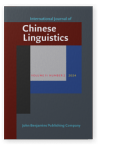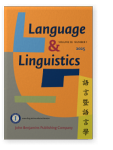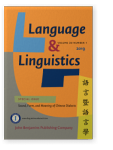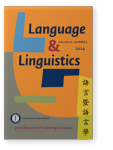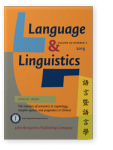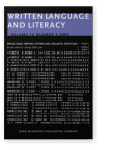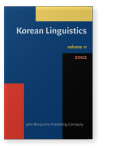Ik-sang Eom
List of John Benjamins publications for which Ik-sang Eom plays a role.
Journals
Title
Sound, Form, and Meaning of Chinese Dialects
Edited by Ik-sang Eom
Special issue of Language and Linguistics 20:1 (2019) ix, 129 pp.
Subjects Altaic languages | Austro-Asian languages | Austronesian languages | Sino-Tibetan languages | Theoretical linguistics
2024 韓漢音的分期與中古到現代的演變 [A periodization of Sino-Korean and phonological changes from Middle to Modern Sino-Korean] Language and Linguistics 25:3, pp. 370–394 | Article
「韓漢音」是漢字的韓語讀音。本文首先探討韓漢音的分期、層次、母胎方言和其時期問題。本文提出將韓漢音分成古代、中古、近代和現代四個時期的依據。為了有效地比較韓漢音與韓語和漢語,本文還建議將古代韓語以七世紀為基準劃分為早期古代韓語和晚期古代韓語。本文還介紹韓漢音層次和母胎方言問題。韓漢音以漢語中古音為基準層次可分為比它早的層次和比它晚的層次。韓漢音母胎方言是七、八世紀漢語中古音。本文還重點分析從中古韓漢音到現代韓漢音音系的主要演變過程。在上古韓漢音時期還沒有完全確立音位地位的送氣音、輔音韻尾、聲調等語音特徵在中古韓漢音時期逐漸定型。中古韓漢音還保持七、八世紀中古漢語四等、重紐等音韻特點。 read more
2019 韓漢同源說的問題與韓漢語言關係 [The problem of the affinity between Korean and Chinese and the relation of the two languages] The interface of semantics & etymology, morpho-syntax, and pragmatics in Chinese, Peck, Jeeyoung (ed.), pp. 131–147 | Article
有些韓語固有詞與對應的上古漢語詞類似。譬如, 表示「風」的韓語固有詞param和「風」字的漢語上古音*prəm類似。一些學者認爲這些韓漢類似詞一定是從同一詞源發展而來,提出韓漢同源說,主張韓語和漢語屬於同一語系。本文將從微觀和宏觀的視角探討該學說是否妥當,並指出韓漢同源說存在的一些問題。本文還將根據陳保亞(1996)的理論,考察了韓漢類似詞在Swadesh (1952; 1955)的100核心詞(第一階詞)和200核心詞減除100核心詞(第二階詞)裏出現的數量。發現第一階核心詞目錄裏主要有「吾、汝、人、男、葉、眼、牙、街、白」等9個韓漢類似詞,第二階核心詞目錄裏也有「日(天)、其、腿、 read more
2009 Discrepancies between sounds and graphs: Irregular readings of Chinese characters Writing Systems and Linguistic Structure, Lee, Sang-Oak (ed.), pp. 188–201 | Article
This article attempts to analyze the causes of the irregular readings of Chinese characters both in Mandarin and in Sino-Korean (i.e. Korean pronunciations of Chinese characters). Cultural taboo, avoidance of confusion and residues of historical and/ or regional sound changes are the main causes… read more
2002 The Origin of Sino-Korean Coda-l Korean Linguistics 11, pp. 101–117 | Article
Abstract Among the stop endings of Middle Chinese entering tone, the alveolar stop -t was consistently changed to -l in Sino-Korean while -p and -k remained the same. In his article in the Journal of East Asian Linguistics, Martin (1997) claims that Sino-Korean coda -l was derived from a liquid of… read more
